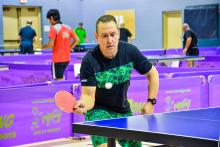We now have 6 weeks before the US nationals! That is just the amout of time that you need to improve your serve return! Check out the latest article that can boost your level!
The Cute Little Guessing Game
About 95% of players say that serve return in their biggest issue. Within this issue, there is one primary problem and then there is a secondary problem that nearly everyone struggles with. First, I’m going to briefly mention the primary problem, then we are going to focus more on the secondary problem in this blog post.
Real Strokes
Nearly all beginner to intermediate level players who walk through my door open their mouth and begin saying…
New Student: I’m just coming to you for serve return. If I could only return that serve, I could beat that guy!
Me: Yes, I watched you play at the club last week. Serve return isn’t your problem.
New Student: Yes it is! If I could just get it back, I would win, I promise you.
Me: Your problem is that you don’t have solid strokes. During the rallies, you can swing somewhat, but on the serve return, you don’t loop, don’t flip, don’t chop, and don’t push. Even when I saw you reading the spin correctly, you still just touched the ball and is went flying off the table. You need to develop your strokes.
See the primary problem is a lack of strokes. If you merely touch the long sidespin serve, you feel the full effect of the spin. If you loop it or chop it or somehow generate your OWN SPIN, then the opponent’s serve will be much more manageable. I just needed to mention this primary point before moving to the main issue in this blog posting. Keep reading…
Guessing Game
The most overlooked aspect of serve return is called the “guessing game”. When sitting on the bleachers, I can see that most tournament players are guessing on the serve. Before the ball is even tossed they have already determined to flip or push or whatever. Is this good or bad? It is good if there is some evidence of what is coming.
Evidence might include:
-Longer backswing indicating deep serve, the receiver prepares to loop
-Extremely open angle hitting the front of the ball, the receiver prepares to move in for the short ball
-No action at the point of contact, the receiver prepares to flip the no-spin serve
-First bounce near the net, the receiver prepares to move in for the short ball
There are actually many evidences of what the serve could possibly be. If you can read these indicators, then and then only can you make a decisive decision on what to do.
Hundreds of times, I have asked players, “Why did you push that long serve to your backhand.” They reply by saying, “Well MY PLAN was to drop-shot the short serve, then he surprised me.” Next serve. “Why did you smash that heavy backspin into the net?” hmmmm…. “Well, I ASSUMED that because he served heavy backspin on the first serve, that he would serve no-spin on the next serve.” This is what I call the CUTE LITTLE GUESSING GAME! You are not playing an assumption, you are playing an opponent! Please, read the body language, read the ball, read the toss, read the racket, read the contact point, read the bounce, but do not try to merely guess what is coming three seconds before the point starts. Just read the indicators, and anticipate! There is a huge difference between anticipating based on what you see vs. merely guessing because you think that you can know what he is thinking.
Do world class players guess? Absolutely! But most of their guessing is based on external evidences and when there are no evidences and they still guess and guess wrong, they are still able to adjust and re-adjust to various serves coming. For example, Zhang Jike sees no evidences that the serve will be short to the middle, however, he cheats sometimes and moves in anyway. If he gets surprised to a different location, his skill set is good enough that he can still return it with quality. Even though he is somewhat guessing, he is still about to adjust well. For most US players, if they guess, then they are unable to return with quality any other way.
Personally, when I’m returning serve, I go through a little checklist for my opponent. Ok, when serving long, this guy wants to pivot and play his forehand from the backhand side. When serving short topspin, it nearly always comes out. When serving short no-spin, he like to prepare from the corners. When serving short backspin, he is ready to move in for the flip. Based on this checklist for this particular opponent, I give myself some specific reminders. If the serve comes long, I prefer to open to the wide forehand because he is looking for the pivot. If the serve is short topspin, it is probably long enough to loop. If the serve is short no-spin try to push short or flip to the middle, he is waiting for the deep corners. If the serve is short backspin, push deep to the backhand, he is waiting for the drop shot.
As you can see, you SHOULD give yourself some tactical reminders against your particular opponent, and you SHOULD look for as many external reminders as possible so that you can decide as early as possible how to best return the serve!
The Cute Little Guessing Game

Should you be playing this game?
Category:



